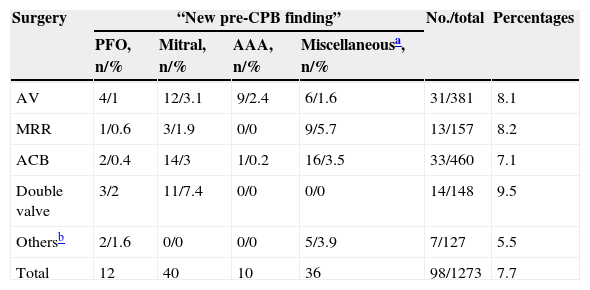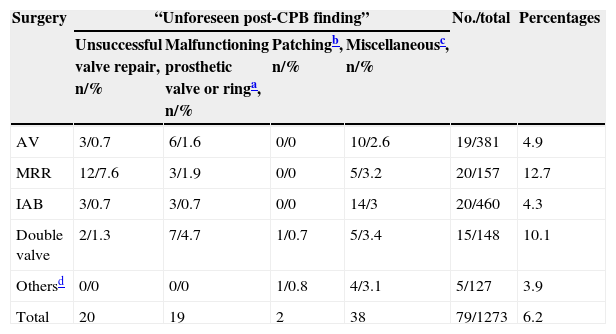To determine the importance of intraoperative transesophageal echocardiography (IOTEE) in the surgical decision in patients undergoing cardiac surgery.
Patients and methodProspective observational study of patients undergoing cardiac surgery from January 2009 to May 2012, which was monitored with IOTEE by the anaesthesiologist in charge. The data collected were: (1) type of surgery; (2) preoperative echocardiographic diagnosis (baseline ECHO); (3) echocardiographic diagnosis before entering cardiopulmonary bypass (CPB) (pre-CPB IOTEE); (4) any differences between the baseline ECHO and the pre-CPB IOTEE (new pre-CPB finding) and whether these differences modified the planned surgery, and (5) echocardiographic diagnosis after disconnection of CPB (unexpected post-CPB finding) and whether these post-CPB echocardiographic findings led to reinstating it. The software program SPSS® was used for data analysis.
ResultsThe total number of patients studied was 1273. Monitoring with IOTEE showed “new pre-CPB” findings in 98 patients (7.7%), and 43.8% of these led to a change in the scheduled surgery. Of these findings, the most frequent were abnormalities of the mitral valve that had not been diagnosed, and which led to a replacement or repair that had not been scheduled. The incidence of “unexpected post-CPB findings” was 6.2% (79 patients), and 46.8% of those required reinstating the CPB and modifying the surgery performed. The failed valve repairs and dysfunctional valve prostheses were the main causes that led to re-entry into CPB. In the remaining 42 patients, with “unexpected post-CPB findings”, there were no changes in the surgical procedure as the echocardiographic findings were not considered to be significant enough to re-establish CPB and revise or change the surgical procedure.
ConclusionIntraoperative monitoring with IOTEE by the anaesthesiologist during surgery provides important information before and after the CPB that resulted in modifying surgical management.
Determinar la importancia de la ecocardiografía transesofágica (ECOTE) intraoperatoria en la decisión quirúrgica en pacientes intervenidos de cirugía cardiaca.
Pacientes y métodoEstudio prospectivo observacional en pacientes de cirugía cardiaca intervenidos desde enero de 2009 hasta mayo de 2012, a los que se monitorizó con ECOTE por el anestesiólogo responsable. Los datos recogidos fueron: 1) tipo de cirugía; 2) diagnóstico ecocardiográfico preoperatorio (ECO basal); 3) diagnóstico ecocardiográfico antes de entrar en circulación extracorpórea (CEC) (ECOTE pre-CEC); 4) si había diferencias entre la ECO basal y la ECOTE pre-CEC (hallazgo nuevo pre-CEC) y si estas diferencias modificaban la cirugía planeada, y 5) diagnóstico ecocardiográfico después de la desconexión de CEC (hallazgo no esperado pos-CEC) y si estos hallazgos ecocardiográficos pos-CEC hacían reinstaurarla. Para el análisis de datos se utilizó el programa de software SPSS®.
ResultadosEl total de pacientes estudiados fue de 1.273; la monitorización con ECOTE mostró «hallazgos nuevos pre-CEC» en 98 pacientes (7,7%) y en 43,8% de estos modificó la cirugía programada; de estos hallazgos, los más frecuentes fueron alteraciones de la válvula mitral que no habían sido diagnosticadas, lo que determinó la sustitución o reparación de la misma que no estaba programada. La incidencia de «hallazgos no esperados pos-CEC» fue del 6,2% (79 pacientes), y de estos, en el 46,8% se requirió reinstaurar la CEC y modificar la cirugía realizada. Las reparaciones valvulares fallidas y las prótesis valvulares disfuncionantes fueron las causas principales que motivaron la reentrada en CEC. En los 42 pacientes restantes, con «hallazgos no esperados pos-CEC», no hubo cambios en la conducta quirúrgica, ya que se consideró que el hallazgo ecocardiográfico no era lo suficientemente significativo como para reinstaurar la CEC y revisar o cambiar el procedimiento quirúrgico.
ConclusiónEn cirugía cardiaca, la monitorización intraoperatoria con ECOTE por el anestesiólogo aporta información importante antes y después de la CEC que modificó el manejo quirúrgico.










